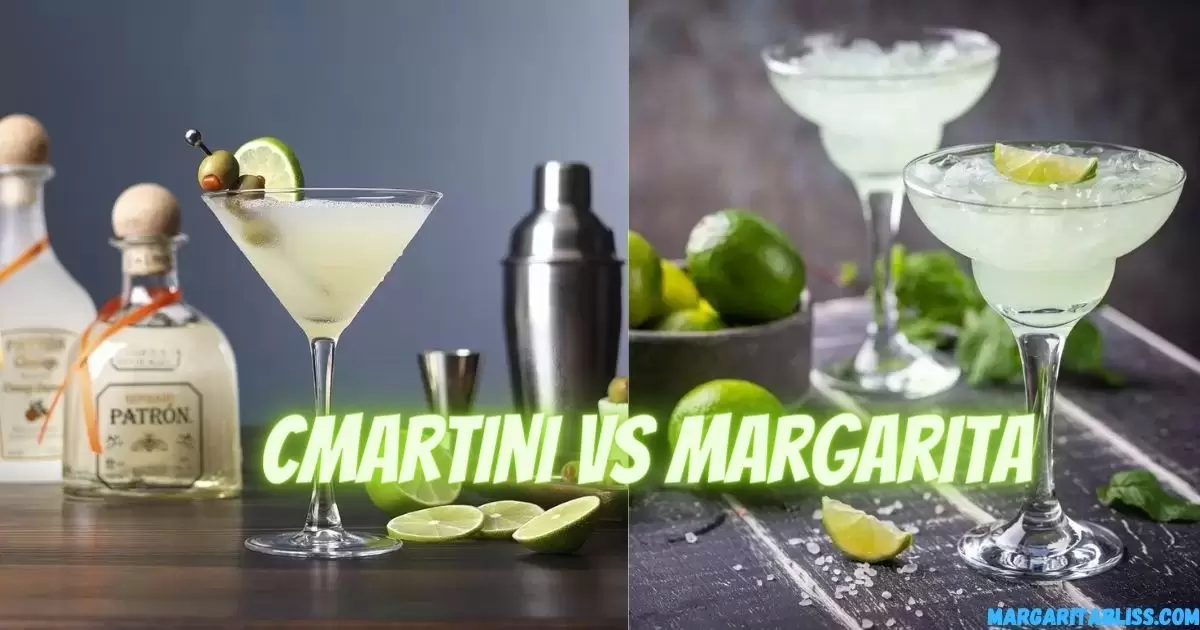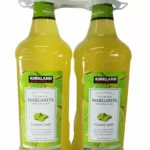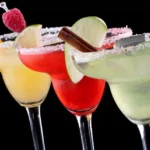A Martini is a classic cocktail made with gin and vermouth, often garnished with an olive or a lemon twist. It’s known for its strong, smooth flavor and is usually served in a distinctive, stemmed glass. On the other hand, a Margarita is a refreshing mix of tequila, lime juice, and triple sec, commonly served with salt on the rim of the glass.
It’s a popular choice for its tangy, sweet taste and is often served blended or on the rocks. Both drinks are staples in the cocktail world, each offering a unique and enjoyable experience. While enjoying a night out, one might wonder, what is the difference between a Martini and a Margarita? Martini is a strong, gin-based drink, while Margarita is a fruity, tequila-infused cocktail.
Each offers a distinct taste and experience, defining moments of pleasure in their own unique way. The Martini has origins tracing back to the late 1800s, symbolizing sophistication with its gin and vermouth blend. The Margarita, with its tequila and lime zest, made a splash in the mid-20th century, quickly becoming a festive favorite.
What is a Martini?
A Martini is a classic cocktail known for its elegance and simplicity. Traditionally made with gin and dry vermouth, it’s stirred or shaken with ice and then strained into a stemmed, cone-shaped glass. The drink is often garnished with an olive or a lemon twist.
While the exact ratios of gin to vermouth can vary, the result is a clear, aromatic, and potent beverage. On National Espresso Martini Day, the Martini has become a symbol of sophistication, immortalized in literature and film, and remains a staple in cocktail culture worldwide.
What is a Margarita?
A Margarita is a popular Mexican cocktail that’s both refreshing and vibrant. It’s typically made with tequila, lime juice, and triple sec, shaken with ice, and served in a glass with a salted rim. The drink can be presented on the rocks, blended with ice, or served straight up.
The Margarita’s sweet and tangy flavor profile, enhanced by the salt’s savoriness, makes it a favorite, especially in warm climates and social gatherings. Its festive nature has cemented its status as a staple in the cocktail world.
Origin and History
Martini: The Martini’s roots are somewhat mysterious, with various stories claiming its creation. Most agree it evolved in the late 1800s, possibly from the Martinez, a cocktail from California during the Gold Rush. Over the years, the Martini has become a symbol of sophistication and class, immortalized in literature and film.
Margarita: The Margarita, meanwhile, is said to have appeared in the mid-20th century. Multiple origin stories exist, but many believe it was invented in Mexico or by Mexican-Americans. It gained popularity rapidly, especially in the United States, becoming synonymous with festive occasions and leisure.
Primary Ingredients
The primary ingredients of these two cocktails set them apart significantly. Here’s a quick comparison.
| Cocktail | Base Spirit | Secondary Ingredients |
| Martini | Gin | Vermouth |
| Margarita | Tequila | Lime Juice, Triple Sec |
Martini: A classic Martini is a blend of gin and vermouth, with the proportions varying according to taste. It’s often garnished with an olive or a lemon twist, adding to its distinct flavor profile. The choice of gin and the ratio of gin to vermouth can significantly affect the drink’s taste.
Margarita: The Margarita is a mix of tequila, lime juice, and triple sec, a type of orange-flavored liqueur. It’s commonly served with salt on the rim of the glass, which complements the cocktail’s sweet and tangy flavor. The quality and type of tequila can greatly influence the overall taste.
Preparation and Serving Style
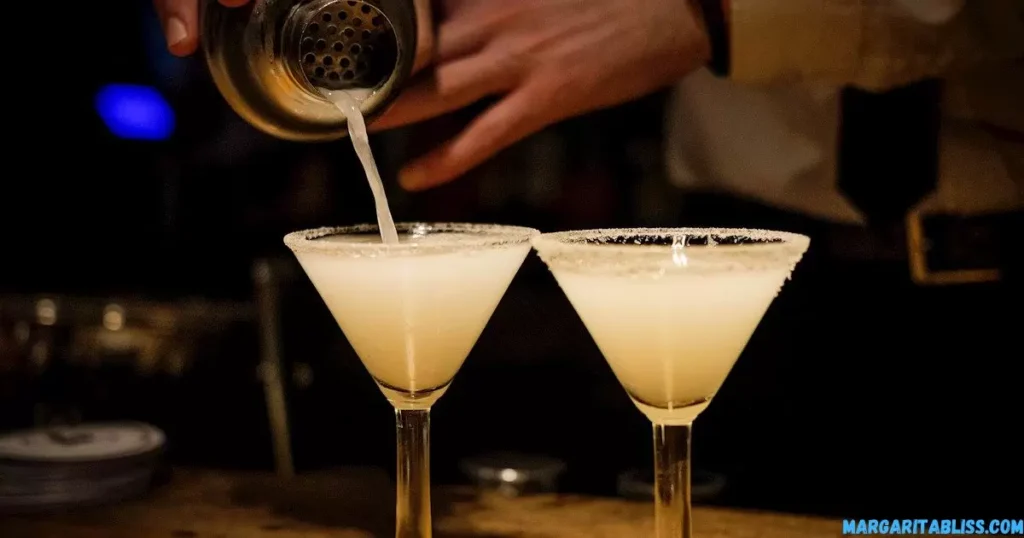
Martini: Preparation style is a crucial aspect of a Martini. It can be shaken or stirred, with enthusiasts often debating which method is superior. Typically, it’s served in a stemmed Martini glass, which has become an iconic symbol of the drink itself.
Margarita: Margaritas can be served on the rocks, blended with ice, or straight up. The traditional glass is somewhat bowl-shaped, which allows for a salted rim. This serving style adds a tactile experience to the drink, enhancing its festive feel.
Taste Profile
Martini: The Martini is known for its dry and aromatic profile, with a strong flavor influenced heavily by the gin used. The vermouth adds a slight sweetness and complexity, while the garnish can introduce a subtle twist to the overall taste.
Margarita: In contrast, the Margarita offers a sweet and sour experience, with the tanginess of lime juice balancing the sweetness of the triple sec. The salt rim adds a savory note that complements the tequila’s robustness, making for a refreshing and invigorating drink.
What’s the difference between a martini glass and a margarita glass?
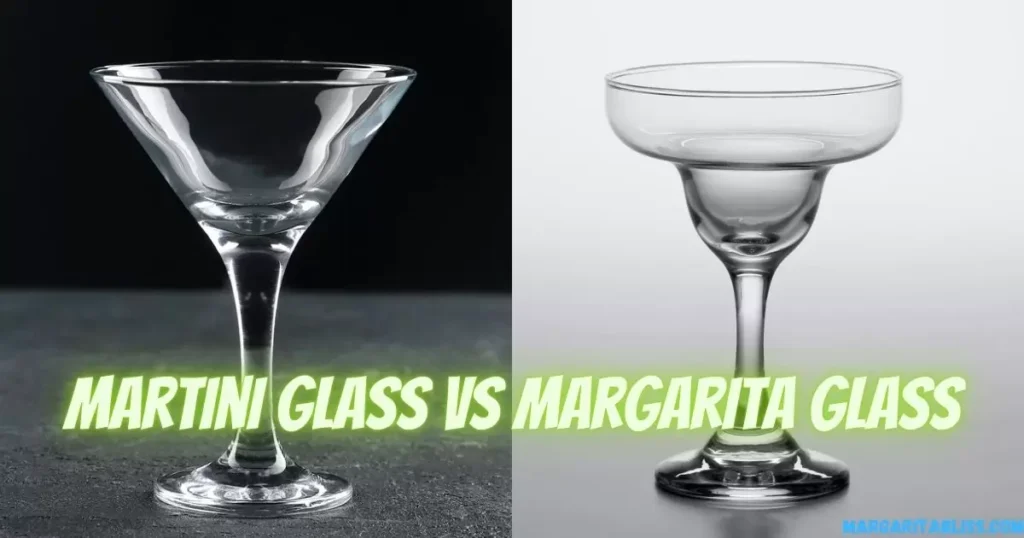
The primary differences between a martini glass and a margarita glass lie in their shape and design, which are tailored to enhance the drinking experience of their respective cocktails.
Martini Glass
Shape: A martini glass typically has a long stem with a wide, cone-shaped bowl that tapers to a point at the bottom. This design is iconic and instantly recognizable.
Purpose: The wide bowl allows for the surface area of the martini to be exposed, enhancing the aroma and flavor. The stem prevents the hand from warming the drink, keeping it at an optimal temperature.
Capacity: Martini glasses usually hold between 5 to 10 ounces, as martinis are often served without ice.
Margarita Glass
Shape: A margarita glass often has a broad-rimmed bowl on top of a stem. The bowl can be somewhat bulbous, wider, and more rounded than a martini glass, resembling a sombrero.
Purpose: The wide rim is perfect for holding the salt or sugar often added to the edge, which complements the flavor of the margarita. The stem, like with the martini glass, helps keep the drink cold by keeping hands away from the bowl.
Capacity: Margarita glasses can vary significantly in size but are generally larger than martini glasses, holding anywhere from 8 to 20 ounces, accommodating the blended or iced version of the drink.
Nutrients Facts Martini vs Margarita
| Nutrient | Martini | Margarita |
| Calories | 210 | 240 |
| Alcohol Content | 14g | 15g |
| Carbohydrates | 0g | 13g |
| Sugars | 0g | 13g |
| Sodium | 0mg | 55mg |
This table provides a comparative overview of the nutritional content of both drinks, including their calorie count, alcohol content, carbohydrates, sugars, and sodium levels.
Similarities Between Martini and Margarita
Martini and Margarita, despite their differences, share several similarities.
Simplicity of Ingredients: They are made with a few simple ingredients, typically including a base spirit, a flavoring agent (like vermouth or lime juice), and sometimes a sweetener.
Customizability: Both cocktails offer room for variation and personalization. Martinis can be made with gin or vodka, shaken or stirred, and garnished with an olive or a lemon twist. Margaritas can be flavored with different fruits, served on the rocks, blended, or with a salted or unsalted rim.
Social Drinks: Both are popular in social settings and are often associated with a sense of celebration, sophistication, or relaxation.
Strong Flavor Profiles: While their flavors are distinct, both are known for having strong, prominent flavor profiles that are immediately recognizable.
When to Choose a Martini or Margarita?
1. Occasion: Choose a Martini for formal or sophisticated events where a classic, elegant drink fits the mood. Opt for a Margarita in casual, festive, or outdoor settings, perfect for adding a lively and fun touch.
2. Flavor Preference: If you prefer a strong, aromatic cocktail with a dry profile, go for a Martini. If you’re in the mood for something sweet, tangy, and refreshing, a Margarita would be the better choice.
3. Base Spirit Likeness: Select a Martini if you enjoy the taste of gin or vodka, as these are the primary spirits. If you’re a fan of tequila and enjoy its robust flavor, a Margarita will suit your palate better.
4. Season or Weather: Consider a Martini in cooler weather or an indoor setting where a potent, less-icy drink can be savored slowly. A Margarita, with its ice and citrus, is ideal for hot weather or a summer party where a cooling drink is desired.
Garnish different Martini vs Margarita
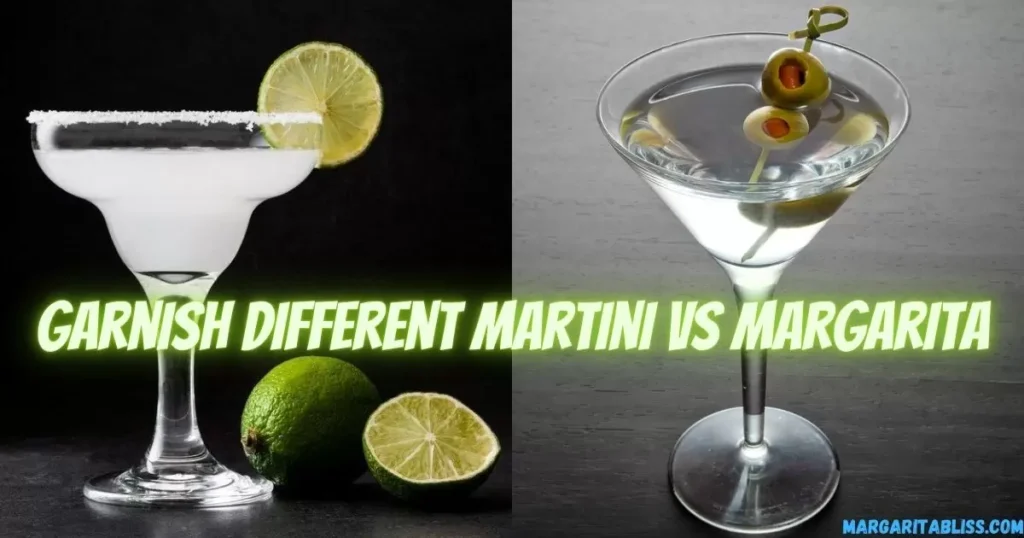
Conclusion
Martinis and Margaritas stand as iconic symbols in cocktail culture, each offering a distinct sensory journey. A Martini, with its gin and vermouth blend, presents an elegant and sophisticated experience, often garnished simply with an olive or lemon twist to enhance its aromatic profile.
It is clear, potent flavor has cemented its status as a symbol of refinement. In contrast, the Margarita, with its vibrant blend of tequila, lime juice, and triple sec, delivers a festive and refreshing experience. Served with a salted rim, this cocktail is synonymous with celebration and leisure.
Both drinks offer room for customization, reflecting personal tastes and the spirit of the occasion. Whether one prefers the dry sophistication of a Martini or the tangy sweetness of a Margarita, each cocktail has a rich history and a dedicated following, proving their enduring appeal and distinct places in the world of mixology.
FAQs
What makes the taste of a Martini different from a Margarita?
A Martini has a more aromatic and dry flavor due to the gin and vermouth, while a Margarita has a sweet, tangy taste from the lime juice and triple sec, along with the distinctive flavor of tequila.
Can both Martinis and Margaritas be customized?
Absolutely! Both can be customized with various flavors and ingredients. Martinis can be made dirty, dry, or with different garnishes, while Margaritas can be flavored with various fruits or even served spicy.
What is the traditional method of mixing a Martini?
Traditionally, a Martini is either stirred or shaken with ice and then strained into a glass. Shaking can make the drink a bit colder and slightly diluted.
Are there non-alcoholic versions of Martinis and Margaritas?
Answer: Yes, non-alcoholic versions of both drinks exist, often called mocktails, which mimic the flavor profiles without including alcohol.
